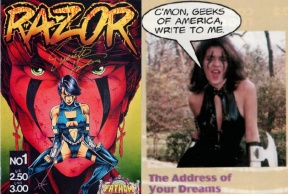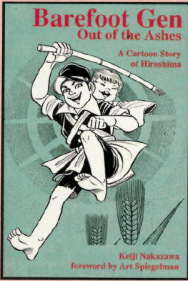Multiversity’s retro-reviews of “Wizard: The Guide to Comics” rolls on. Let’s look back at the top news stories from April 1996 and judge them as harshly as we can!

A Bold Move, Likely a Bad Move
Every Fall, “Wizard” ran a contest where readers submitted pictures of themselves dressed as comic characters for Halloween. In 1994, they published one of a young woman named Paula dressed as Vampirella. Her costume was pretty revealing, obviously, and it inspired a bunch of approving (and semi-gross) letters from men that were run in the Magic Words column over the next few months. When Paula didn’t appear in the 1995 contest, more men (boys?) wrote in to ask where she was. This issue included a letter from her apologizing to those males for not getting her submission in on time. Her picture (below) was run in this month’s issue along with a PO box number so fans of the image could write to her directly. Jim McLauchlin, the guy responding to the letters, noted that he thought this was a bad idea and advised readers to keep their letters to her tasteful. Paula, if you’re out there, I’d love to hear how this worked out for you.

Onslaught
After being hinted and teased for a few months, Onslaught is officially announced as the big X-crossover for 1996 and as the catalyst for the Heroes Reborn revamp due in September, although that project was still codenamed “unfinished business”. I’ve never read the Onslaught saga, mostly because I was unable to keep up with it financially in 1996, but I do remember being super excited by the imagery and tidbits shared with me by friends who were reading it. I suspect that if I read it now, it wouldn’t hold up to what I had imagined.
Amalgam
The big news story of the month was the temporary formation of Amalgam Comics. In the midst of the big “Marvel vs DC” miniseries pitting the companies’ characters against one another, the editors in charge decided to do something really unexpected: instead of releasing their normal comic loads, Marvel and DC took a week off, mashed up some of their characters (think of the recent “Infinity Warps”), and released them in twelve one-shots under the Amalgam Comics banner. Craig Shutt interviewed the various creative teams, and the combined responses give the impression that this was a very loose project where everyone just did what would be fun. Some characters even got used twice: Dark Claw (Wolverine + Batman) got the cover treatment seen above, but there was also “Bruce Wayne: Agent of S.H.E.I.L.D.” Wonder Woman was smooshed with Storm in “Amazon”, then partnered with Punisher in “Bullets and Bracelets”. Perhaps the most unexpected choice was combining Daredevil with Deathstroke and getting a female character that cashed in on the Bad Girl trend that was already on its way out of fashion. A sidebar let the creators discuss unused ideas, like Super-Hulk and leading every story with “Mort Lieber presents”. Mark Waid was allowed to combine Green Arrow/Oliver Queen with Goliath, but wasn’t allowed to call the character Giant Queen. Peter David, ever the funny man, said he was still waiting for the chance to write the ultimate team-up: Vision & the Scarlet Witch vs Casper & Wendy the Good Witch.
Features
Q&A with Billy Tucci, the creator of “Shi”. He gave some background on the book and his creative process before Rob Allstetter began hitting him with bigger questions like “What do you think is wrong with the comic industry?” Tucci answered that there had been a focus on quantity over quality and that many books were being written poorly. Interestingly, he cited his own high sales as a problem. He was happy with the numbers, but also felt the industry was in trouble if his little book could outsell Superman and Batman.
Fit to Print was a ten-item listicle giving readers tips on how to get their letters printed in comic books. Back when a book like “Spawn” received 500 letters a week, I guess you really had to work to stand out. One letter-hack interviewed said he wrote 20 letters a week and would sometimes go 10 months without any of them appearing in the back pages. Getting published is not such a feat nowadays. I’ve written perhaps ten letters to comics that I liked, and only one didn’t printed. Shoot, a couple years ago, I wrote a few sentences to a comic that didn’t have a letters column just to let the team know that I liked it, and they started a letter column just to print my brief comments. It promptly disappeared.
Continued belowFirst Look was a puff piece for “Spider-Man: Legacy of Evil”. The 48-page story has an impressive pedigree (Kurt Busiek’s writing over Mark Texeira’s painted artwork), but it’s essentially a primer for the original Green Goblin. Gobby had been dead for a while, but he was about to return as the mastermind of the clone madness tearing through Spider-Man’s regular books. “Legacy of Evil” might be a good story – I’ve never read it – but a it appears to have left a weak legacy itself. Back issues are currently selling for half of the 1996 cover price.
Sonic Youth is a four-page piece by Matthew Brady with a historical look at teenage heroes as stars instead of in supporting roles. It tracked the popularity and usage of teens against real world politics and views. I found it fascinating, partly for its insights but also because it’s not an obvious topic. This seems like a subject that could use a modern update.

American Manga is a strange thing. It’s six pages of popular American artists talking about how Manga inspired them and their work. It lacks focus and ends without a clear reason for existing. I think it was supposed to be some sort of peer pressure/propaganda thing – “Joe Madureira and Art Adams like Manga, so it’s ok for you to like it too”.
Fax of Life and Death was a promo piece for a nonfiction comic work by Joe Kubert. A friend of his lived in Sarajevo during the Bosnia conflict. For two years, the only way he could communicate with the outside world was by fax. Kubert, compelled to share his friend’s experience, turned his collection of faxes into “Fax from Sarajevo”. The graphic novel was published by Dark Horse and combined the text of the faxes with Kubert’s illustrated interpretation of them. A promotional excerpt was distributed at book fairs to generate interest, and based on the content of that ashcan alone, Kubert won an Italian award for promoting understanding.
In Krash Course, Greg Capullo provides some tips on how to tell a story with panels instead of just putting pictures beside one another. This is a fundamental for comics, but not always intuitive.
Not much new in Trailer Park this month. The Silver Surfer cartoon was official but still upcoming. Spider-Man was renewed for season five, and the creators hoped to make 100 episodes after that. James Cameron still hoped to make a Spider-Man film, but legal difficulties with the rights led him to start work on some film called Titanic instead.

Picks
You know how back in the Silver Age of Superheroes, stories were really packed, sometimes fitting two whole tales in a single issue? And how in recent decades, decompression has become a popular way to stretch stories across six or more issues? Wouldn’t it be great if someone went back to classic tales, like the wedding of Reed Richards and Sue Storm, and retold them with modern sensibilities, fleshing them out but staying true to continuity so nothing was altered and the new story content was ultimately pointless? Well, your wish was granted in March 1996 when Marvel published “Marvel Heroes” #1. And it was going to be a quarterly!
Strangely, my research shows this comic wasn’t actually published until October. When the second issue came out, it was now a “once a year tradition”. There was no third issue. I think “Wizard” really missed with this particular pick.
The other top pick of the month was “Concrete: Think Like a Mountain” #1. I’m a big Concrete fan, and this mini was one of my favorites. I think “Wizard” was spot on with this particular pick.
Top 10 Comics
Not much changed from last month. “Preacher” #1 moved up. “DC Versus Marvel” #1 appeared. “Glory” #1 appeared. Yawn.
Market Watch
“Marvel vs DC” was super popular despite its $3.95 cover price at a time when most comics were between $1.50 and $2.50. Retailers were selling out of it, but the print run was high enough that all reorders were being filled without any trouble. Meanwhile, sales for early Silver Age books were strong as speculators began to leave flavors-of-the-month behind for tried-and-true value holders.
The price guide’s letter column featured another writer asking if polybags would really damage a comic if it wasn’t removed. The answer involved some basic chemistry and suggested that bags should be replaced every ten years. This came across as sound, but I recently bought books that had been bagged for nearly 25 years, and there was no appreciable difference between them and unbagged comics of the same era. Has anyone ever reported damage from a polybag?
Bizarre collectible
The merchandise company Comic Images somehow partnered with Mongolia to release X-Men stamps. The stamp sheet was almost completely in English, and the stamps are only good in Mongolia. They retailed for $10 and were aimed at that small subset of X-Men fans and philatelists, I guess? Eh, I bet everyone who paid for them liked them, so who am I to judge?
John Byrne
Up until this issue, most “Wizards” included an editorial column from Todd McFarlane called E.G.O. – Everyone’s Got Opinions. Said columns were mostly rambling and self-contradictory, and they ran in last few pages of the magazine. I’m pretty sure this was McFarlane’s attempt to mimic Peter David’s But I Digress column from “Comic Buyer’s Guide”.
McFarlane’s column has been flaky, and it has been entirely absent so far in 1996. Now it seems to have been replaced by (one of) McFarlane’s philosophical enemies, John Byrne in a column cleverly titled John Byrne. He talks about the first comic he read and how he still treasures it forty years later. Then he muses about whether the 90s kid whose first comic had a chromium cover instead of a fun story will treasure it in forty years.
Well Mr Byrne, it hasn’t quite been forty years and I didn’t get a chromium cover until my collection was about 20 comics strong, but yes, I still treasure them. I actually have a designated spot in my collection for “special” comics that I own for a unique cover enhancement (or some other reason beyond the story content). I hope this pleases you.






